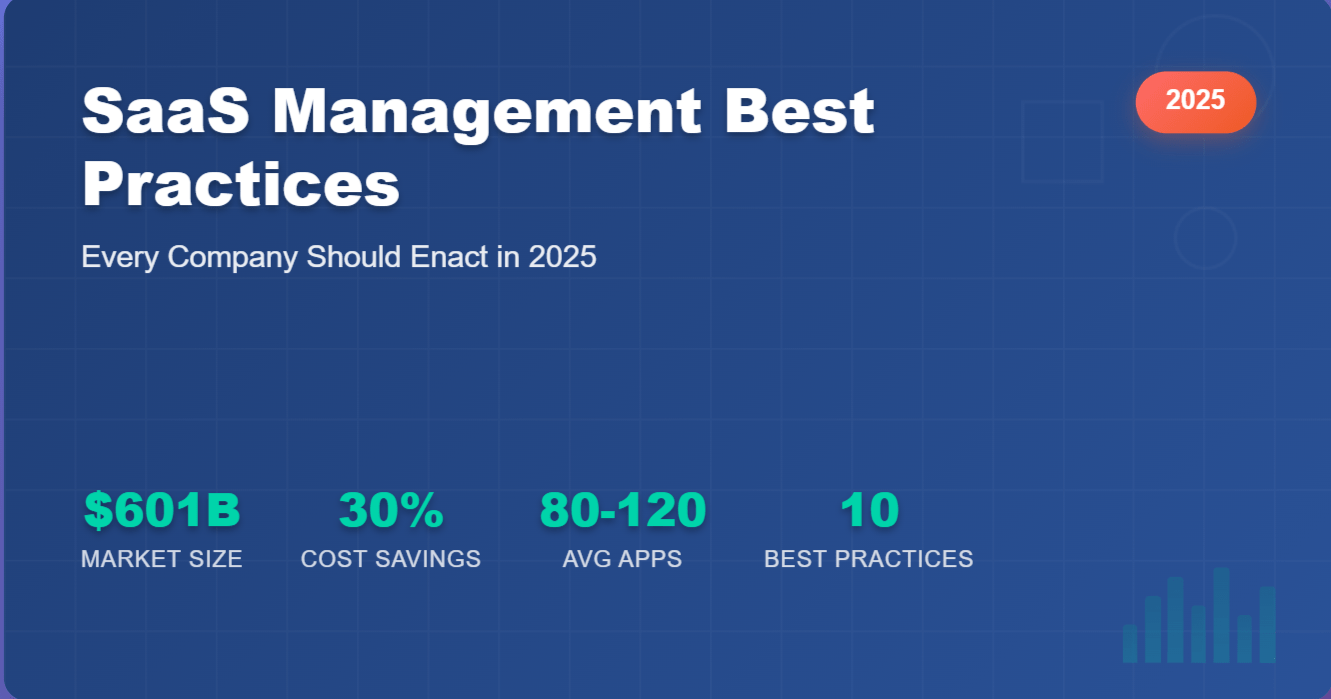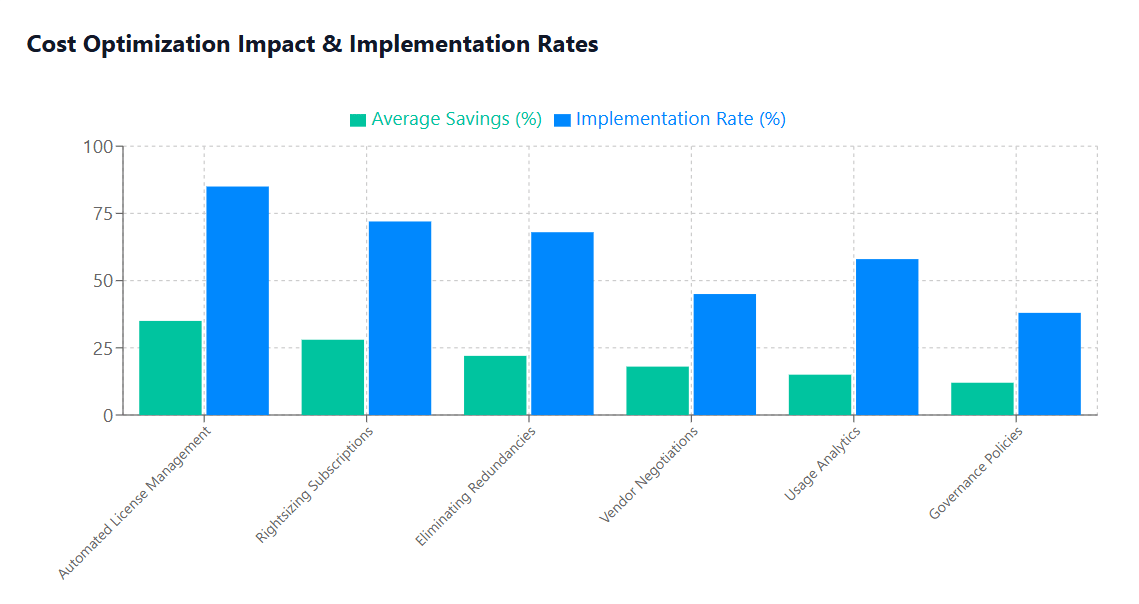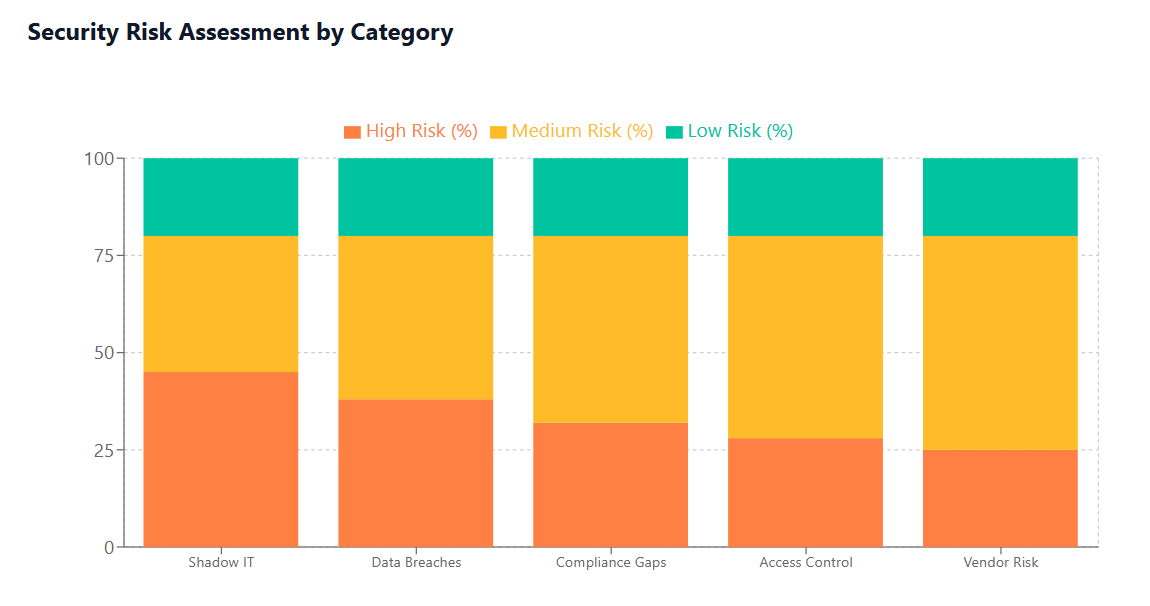
The Software as a Service (SaaS) landscape has fundamentally transformed how organizations operate, collaborate, and scale their businesses. As we advance into 2025, companies are increasingly dependent on diverse SaaS applications to drive productivity, streamline operations, and maintain competitive advantages. However, this growing reliance on SaaS solutions brings unprecedented challenges in management, cost control, and strategic oversight.
Modern enterprises typically utilize between 80-120 SaaS applications across various departments, creating a complex ecosystem that requires sophisticated management approaches. Without proper governance and strategic planning, organizations face significant risks including security vulnerabilities, budget overruns, compliance issues, and operational inefficiencies. The need for comprehensive SaaS management has never been more critical.
This guide presents the essential best practices every company should implement in 2025 to effectively manage their SaaS portfolio, optimize investments, and maintain operational excellence while mitigating risks associated with uncontrolled SaaS adoption.
The Evolution of SaaS Management in 2025
The SaaS management landscape has evolved dramatically, driven by increased remote work adoption, digital transformation initiatives, and the proliferation of specialized software solutions. Organizations now face the challenge of managing not just the software itself, but the entire lifecycle of SaaS applications from procurement to retirement.
In 2025, successful SaaS management extends beyond simple cost tracking to encompass strategic planning, risk management, and value optimization. Companies are recognizing that effective SaaS subscription management requires dedicated resources, specialized tools, and structured processes that align with broader business objectives.
The key drivers shaping SaaS management practices include the need for better cost visibility, enhanced security protocols, compliance requirements, and the demand for measurable return on investment. Organizations are moving from reactive management approaches to proactive, strategic frameworks that anticipate needs and optimize resources before problems arise.

Establishing a Centralized SaaS Governance Framework
Creating a robust governance framework forms the foundation of effective SaaS management. This framework should establish clear policies, procedures, and accountability structures that guide all SaaS-related decisions across the organization.
Core Components of SaaS Governance
A comprehensive governance framework includes defined approval processes for new SaaS acquisitions, standardized evaluation criteria for vendor selection, and clear ownership responsibilities for different aspects of SaaS management. Organizations should establish a SaaS governance committee comprising representatives from IT, finance, security, and business units to ensure holistic decision-making.
The governance framework must also address data classification standards, integration requirements, and exit strategies for each SaaS application. This includes defining acceptable use policies, establishing service level agreements with vendors, and creating procedures for handling contract negotiations and renewals.
Implementing Policy and Compliance Standards
Effective governance requires clear policies that address security requirements, data handling procedures, and compliance obligations. These policies should be regularly updated to reflect changing regulations, emerging threats, and evolving business needs. Organizations must ensure that all SaaS applications comply with relevant industry standards and regulatory requirements such as GDPR, HIPAA, or SOX.
Regular audits and assessments should be conducted to verify compliance and identify potential gaps in the governance framework. This includes reviewing vendor certifications, conducting security assessments, and validating data handling practices across all SaaS applications.
Implementing Strategic SaaS Procurement Processes
Strategic procurement goes beyond simply purchasing software licenses to encompass comprehensive vendor evaluation, contract negotiation, and long-term relationship management. Organizations should develop standardized procurement processes that ensure consistency, compliance, and optimal value realization.
Vendor Evaluation and Selection
Establishing rigorous vendor evaluation criteria helps organizations select SaaS solutions that align with business objectives and technical requirements. Evaluation factors should include functionality alignment, integration capabilities, security posture, vendor stability, and total cost of ownership considerations.
The evaluation process should involve multiple stakeholders and include proof-of-concept testing, reference checks, and detailed security assessments. Organizations should maintain a preferred vendor list and establish standardized evaluation templates to streamline the selection process while ensuring comprehensive assessment coverage.
Contract Negotiation Best Practices
Effective contract negotiation requires understanding both business needs and market dynamics. Organizations should negotiate terms that provide flexibility for changing requirements, appropriate service level agreements, and favorable pricing structures. Key negotiation areas include data ownership rights, termination clauses, service availability guarantees, and pricing escalation protections.
Professional procurement teams should be involved in significant SaaS negotiations to ensure optimal commercial terms and risk mitigation. This includes negotiating volume discounts, multi-year commitments where appropriate, and ensuring adequate contract terms for data security and compliance requirements.
Optimizing SaaS Spend and Budget Management
Cost optimization represents one of the most immediate and measurable benefits of effective SaaS management. Organizations can achieve significant savings through strategic rightsizing, elimination of redundant applications, and improved contract negotiations.
Understanding Your SaaS Spend Landscape
Comprehensive spend visibility requires aggregating cost data from multiple sources including corporate credit cards, procurement systems, and departmental budgets. Organizations should implement cloud cost optimization strategies that provide real-time visibility into spending patterns and trends.
Regular spend analysis helps identify optimization opportunities such as underutilized licenses, duplicate applications, and opportunities for consolidation. This analysis should consider both direct costs and indirect expenses such as training, integration, and support requirements.
Implementing Cost Control Measures
Effective cost control requires establishing spending thresholds, approval workflows, and automated alerts for unusual spending patterns. Organizations should implement budget controls that prevent unauthorized purchases while maintaining business agility for necessary acquisitions.
Regular reviews of license utilization help identify opportunities to optimize Office365 cost and other major SaaS applications. This includes rightsizing subscriptions based on actual usage patterns and negotiating more favorable terms during renewal periods.
Leveraging SaaS Management Platforms
Modern SaaS management platforms provide comprehensive visibility and control capabilities that manual processes cannot match. These platforms offer features such as automated discovery, usage analytics, cost optimization recommendations, and renewal management capabilities.
When selecting a SaaS management platform, organizations should prioritize solutions that offer robust integration capabilities, comprehensive reporting features, and automated workflows that reduce administrative overhead while improving control and visibility.

Automating License Management and Renewals
Manual license management processes are prone to errors, inefficiencies, and missed optimization opportunities. Automation helps organizations maintain accurate license inventories, optimize utilization, and prevent unexpected renewals or service interruptions.
Automated Discovery and Inventory Management
Automated discovery tools help organizations maintain accurate inventories of all SaaS applications in use across the enterprise. These tools can identify shadow IT applications, duplicate subscriptions, and unauthorized software usage that might otherwise go undetected.
Regular automated scans should be conducted to identify new applications, changes in usage patterns, and potential security risks. This information should be integrated with existing IT asset management systems to provide comprehensive visibility across all technology resources.
Renewal Management and Optimization
Automated renewal management helps organizations avoid surprise renewals, negotiate better terms, and optimize subscription levels based on actual usage. This includes setting up automated alerts for upcoming renewals, analyzing usage patterns to inform renewal decisions, and coordinating with vendors to ensure optimal contract terms.
Organizations should establish renewal calendars that provide sufficient lead time for evaluation, negotiation, and decision-making. This process should include usage analysis, cost-benefit evaluation, and assessment of alternative solutions to ensure continued value realization.
Enhancing SaaS Security and Compliance
Security considerations are paramount in SaaS management, as organizations must rely on third-party vendors to protect sensitive data and maintain appropriate security controls. Comprehensive security programs must address both vendor security capabilities and organizational security practices.
Implementing Security Assessment Frameworks
Regular security assessments help organizations understand the security posture of SaaS vendors and identify potential risks. These assessments should evaluate vendor security certifications, data handling practices, incident response capabilities, and compliance with relevant security standards.
Organizations should establish security requirements that all SaaS applications must meet and conduct regular reviews to ensure continued compliance. This includes evaluating vendor security practices, monitoring security incidents, and assessing the impact of security changes on organizational risk profiles.
Data Protection and Privacy Considerations
Data protection requirements vary by industry and jurisdiction, requiring organizations to implement appropriate controls for sensitive information. This includes understanding data residency requirements, implementing appropriate access controls, and ensuring compliance with privacy regulations.
Organizations should establish data classification schemes that determine appropriate protection requirements for different types of information. SaaS applications should be selected and configured based on their ability to meet these protection requirements while maintaining operational efficiency.

Leveraging Analytics for Data-Driven Decisions
Analytics capabilities enable organizations to make informed decisions about SaaS investments, usage optimization, and strategic planning. Comprehensive analytics should cover usage patterns, cost trends, user satisfaction, and business value realization.
Usage Analytics and Optimization
Detailed usage analytics help organizations understand how SaaS applications are being utilized across different user groups and business functions. This information enables optimization decisions such as rightsizing subscriptions, identifying training needs, and eliminating underutilized applications.
Regular usage reviews should be conducted to identify trends, anomalies, and optimization opportunities. This analysis should consider both quantitative metrics such as login frequency and feature utilization, as well as qualitative factors such as user satisfaction and business impact.
Performance Monitoring and Optimization
Continuous monitoring of SaaS application performance helps organizations identify issues before they impact business operations. This includes monitoring availability, response times, and integration performance to ensure optimal user experience.
Organizations should establish performance baselines and alert thresholds that enable proactive issue resolution. Regular performance reviews should be conducted with vendors to address any performance concerns and optimize application configurations for improved efficiency.
Managing Vendor Relationships and Negotiations
Strong vendor relationships are essential for maximizing value from SaaS investments and ensuring responsive support when issues arise. Organizations should develop structured approaches to vendor management that encompass relationship building, performance monitoring, and strategic planning.
Building Strategic Partnerships
Successful SaaS management requires moving beyond transactional vendor relationships to develop strategic partnerships that benefit both organizations. This includes establishing regular communication channels, collaborative planning processes, and mutual performance objectives.
Strategic partnerships enable organizations to influence vendor roadmaps, gain early access to new features, and receive preferential support during critical situations. These relationships require ongoing investment in communication, feedback, and collaborative problem-solving.
Performance Management and Accountability
Regular vendor performance reviews help ensure that SaaS applications continue to meet business requirements and service level expectations. These reviews should assess both technical performance and relationship quality to identify improvement opportunities.
Organizations should establish clear performance metrics and accountability structures that enable objective evaluation of vendor performance. This includes tracking service availability, support responsiveness, and business value delivery to inform renewal and expansion decisions.
Creating Effective User Onboarding and Offboarding
User lifecycle management represents a critical component of SaaS management that directly impacts security, compliance, and cost optimization. Organizations must implement standardized processes for user provisioning, access management, and account deprovisioning.
Streamlined Onboarding Processes
Effective onboarding processes ensure that new users can quickly access required SaaS applications while maintaining appropriate security controls. This includes automated provisioning workflows, standardized access templates, and comprehensive training programs.
Organizations should establish role-based access templates that simplify user provisioning while ensuring appropriate access controls. Regular reviews of access patterns help identify optimization opportunities and potential security risks that require attention.
Secure Offboarding Procedures
Comprehensive offboarding procedures ensure that departing employees lose access to SaaS applications in a timely manner while preserving important business data. This includes automated deprovisioning workflows, data transfer procedures, and license reclamation processes.
Organizations should establish automated workflows that trigger offboarding activities based on HR system changes. Regular audits of user access help identify dormant accounts and ensure that offboarding procedures are being followed consistently.
Future-Proofing Your SaaS Strategy
As the SaaS landscape continues to evolve, organizations must develop strategies that anticipate future needs and adapt to changing market conditions. This includes staying informed about emerging technologies, evolving best practices, and changing regulatory requirements.
Emerging Technology Integration
New technologies such as artificial intelligence, machine learning, and edge computing are creating new opportunities for SaaS innovation and optimization. Organizations should evaluate how these technologies can enhance their SaaS management capabilities and business operations.
Integration capabilities will become increasingly important as organizations seek to create seamless workflows across multiple SaaS applications. This includes API management, data integration, and workflow automation capabilities that enable efficient cross-application processes.
Scalability and Flexibility Planning
Future-ready SaaS strategies must accommodate changing business requirements, user growth, and technological evolution. This includes selecting SaaS applications with robust scaling capabilities and flexible licensing models that adapt to changing needs.
Organizations should regularly review their SaaS portfolio to ensure that current solutions can support future growth and changing requirements. This includes evaluating vendor roadmaps, assessing integration capabilities, and planning for potential technology migrations.
Conclusion
Effective SaaS management in 2025 requires a comprehensive approach that encompasses governance, procurement, cost optimization, security, and strategic planning. Organizations that implement these best practices will achieve better control over their SaaS investments, reduce risks, and maximize value realization from their software portfolios.
The key to success lies in treating SaaS management as a strategic discipline rather than a tactical activity. This requires dedicated resources, appropriate tools, and ongoing commitment to continuous improvement and optimization.
By establishing centralized governance frameworks, implementing strategic procurement processes, leveraging automation capabilities, and maintaining focus on security and compliance, organizations can navigate the complex SaaS landscape while achieving their business objectives efficiently and effectively.
The investment in proper SaaS management pays dividends through reduced costs, improved security posture, enhanced operational efficiency, and better alignment between technology investments and business outcomes. Organizations that prioritize these best practices will be well-positioned to leverage SaaS solutions as competitive advantages in the evolving digital landscape.
For organizations looking to enhance their SaaS management capabilities, platforms like Binadox provide comprehensive solutions that automate discovery, optimize spending, and streamline governance processes. By implementing these best practices and leveraging appropriate tools, companies can transform their SaaS management from a source of complexity into a strategic advantage that drives business success.

